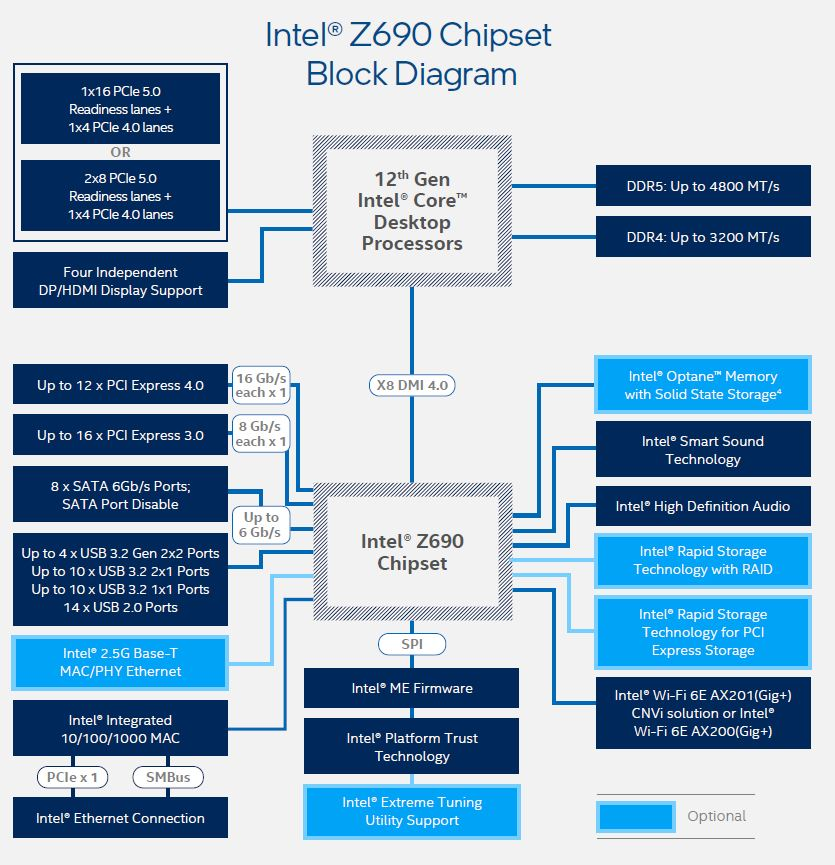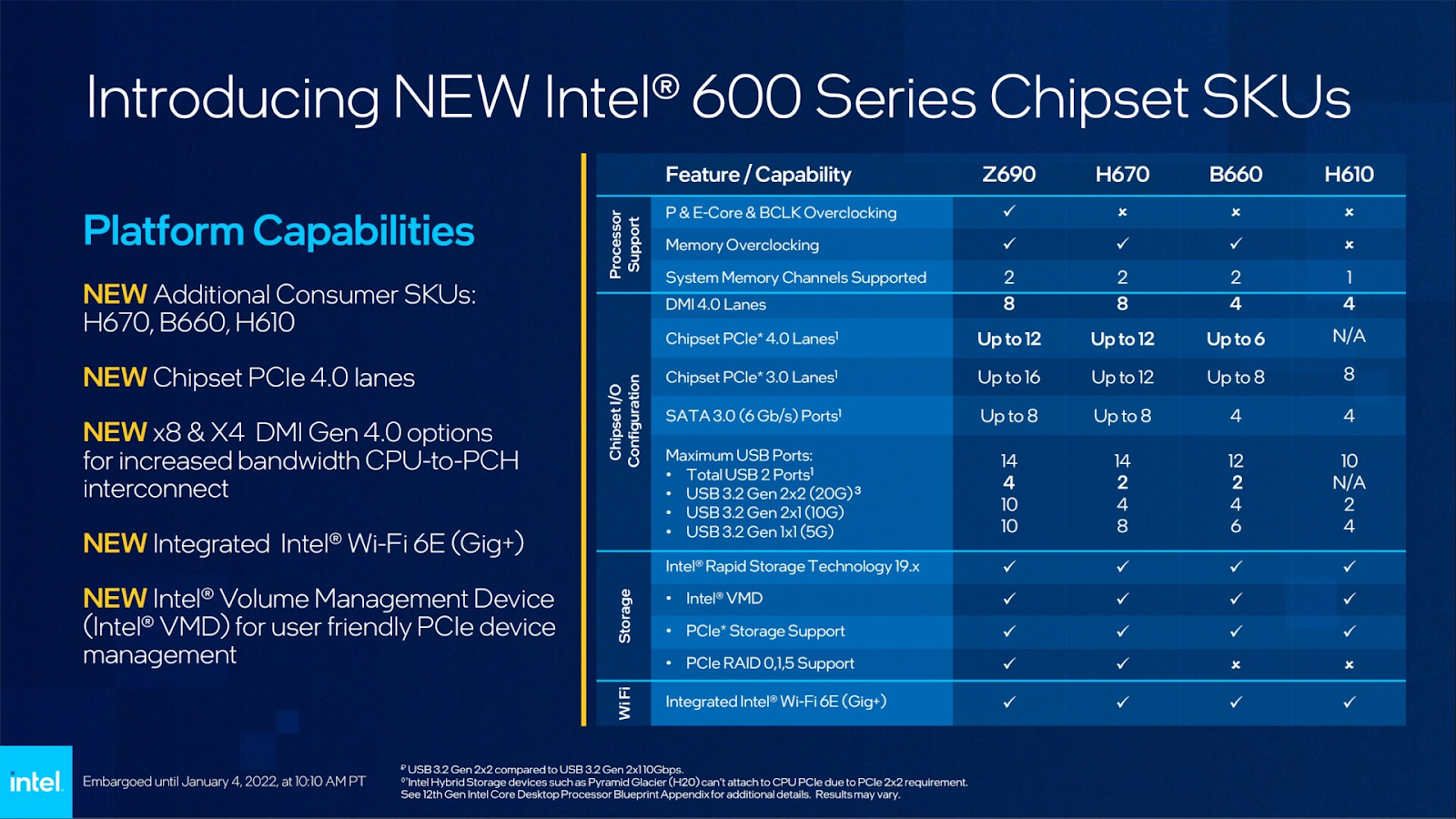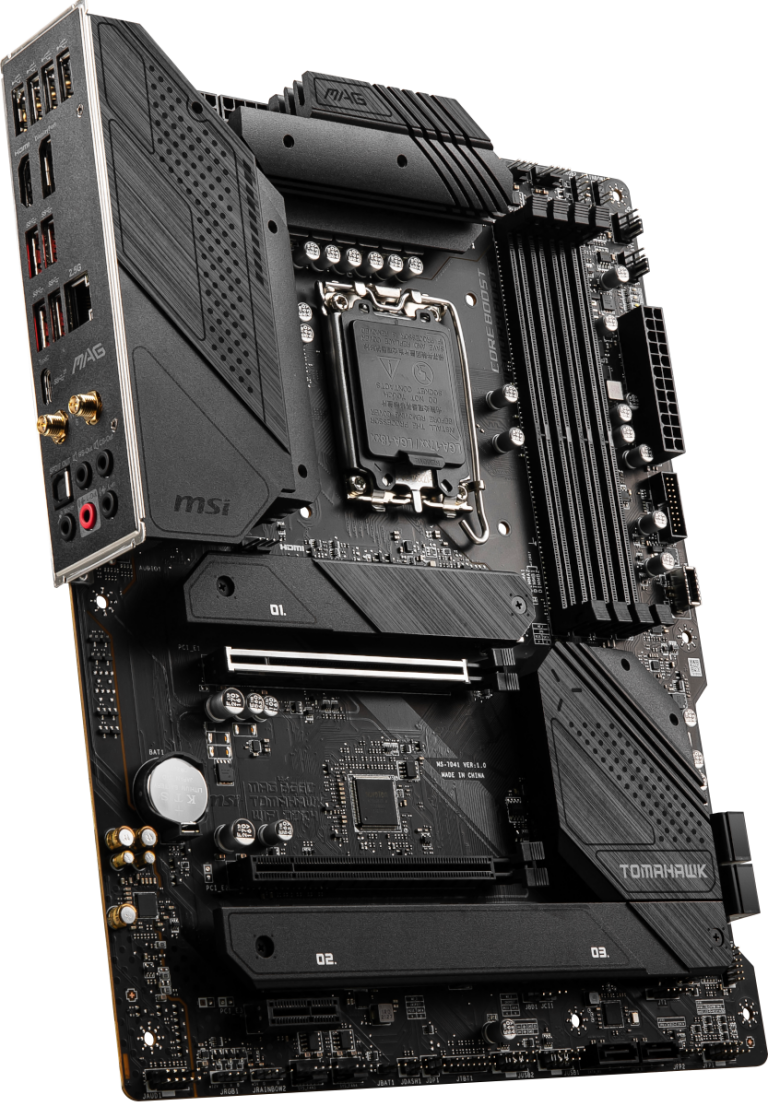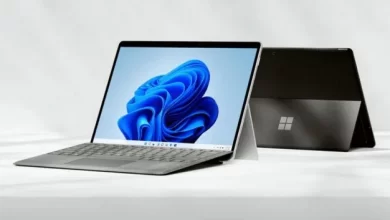Intel’s New Alder Lake Desktop Chipsets: H670, B660, and H610
As new technologies permeate motherboard chipsets, they tend to evolve slowly. This was not the case when Intel introduced its Z690 chipset in late 2021. For 11th Generation “Rocket Lake” CPUs, Intel released a slew of upgrades that put the Z690 chipset significantly ahead of the outgoing Z590 chipset. It’s without a doubt the most significant change to Intel’s chipsets in at least a decade.
With Intel’s unveiling of Z690’s stepped-down siblings at CES 2022, we now know that many of these improvements will also be included in Intel’s new H670, B660, and H610 chipsets. These new chipsets are all fairly groundbreaking, and two of them significantly outperform their direct predecessors, albeit the bottom-end H610 chipset is a little more limited than we may have hoped.
Contents
A Quick Review of the Z690
We’ve already gone through the Z690 chipset in detail in another article, but we’ll outline it here to help with comparisons. The Z690 is Intel’s first motherboard chipset to support DDR5 RAM, as well as XMP 3.0, a new memory-profiling technology released alongside the first Alder Lake motherboards.

The chipset now includes a PCI Express (PCIe) 4.0 controller, as well as an increase in the number of USB ports supported. The USB jump is something we’ve learned to expect with each new chipset generation, but the PCIe 4.0 controller stands out because it provides double the bandwidth of PCIe 3.0, and AMD Ryzen systems have already reached 4.0. This faster interface is currently used to handle ultra-high-speed NVMe SSDs with rates of up to 64Gbps, but it could potentially be beneficial when using SLI or CrossFire to link multiple graphics cards.
The introduction of an x8 DMI 4.0 connection between the chipset and motherboard is the last noteworthy modification Intel made to the Z690. This is where most system devices communicate with the CPU, and all data on storage devices must also flow through.
H670: A Business-Oriented Z690 Clone
The new H670 chipset from Intel is the most feature-rich option after the Z690, but it’s not one you’ll see outside of the office. Traditionally, Intel’s H-series chipsets have been aimed at corporate applications and are essentially modified versions of their Z-series equivalents.
There are only a few differences between the Z690 and the H670, the most prominent being the lack of CPU overclocking and minor USB support restrictions. All contemporary USB kinds, including superfast USB 3.2 Gen 2×2 (20Gbps) ports, are supported by the H670 chipset, but fewer of these ports are supported. The Z690 board can have up to four 20Gbps USB ports, but the H670 board can only have two. The maximum number of USB 3.2 Gen 2×1 (10Gbps) ports has also been reduced from 10 to 4.
Intel has reduced the number of USB 3.2 Gen 1×1 (5Gbps) connections from ten to eight, and PCIe 3.0 lanes from sixteen to twelve. These changes are insignificant in the grand scheme of things. The loss of overclocking support is the most notable, but it’s not a major concern for a commercial system. The loss of USB compatibility is a more major blow for business customers, but H670 still offers enough of high-speed USB connectivity, and most users won’t notice the difference.
What’s more essential is that H670 preserves all of its characteristics. Because the number of PCIe 4.0 lanes remains unchanged, a H670-based motherboard could theoretically support three PCIe 4.0 M.2 Key M NVMe SSDs. RAID support is also there, as is integrated Intel Wi-Fi 6E compatibility, and a full DMI 4.0 x8 connection to support it all.
B660: The Mainstream Alternative Is Now More Reliable Than Ever
B-series motherboards are typically the rock-solid value soldiers for non-tweaking and overclocking enthusiasts. The first big loss in overall features occurs with B660 in this generation. However, the boards are still appealing for everyday systems.
Not only is CPU overclocking no longer possible, but RAID support has also been removed, and PCIe 4.0 support has been reduced by half. Unlike the Z690 and H670, which can handle three PCIe 4.0 M.2 Key M NVMe SSDs, the B660 can only support one off the chipset itself. The number of PCIe lanes has also been reduced to eight, which is half of what the Z690 has. However, the loss is more noticeable here than it was with H670, because not only are there fewer lanes available, but the reduction in PCIe 4.0 lanes makes these lanes even than important for supporting additional M.2 Key M SSDs.
For some borderline power users, the loss of PCIe support may be a bitter pill to take, but this design decision makes sense in several ways. PCIe 3.0 devices account for the majority of the M.2 SSD market, and most users are unlikely to have more than one or two M.2 SSDs in their system. People who have more M.2 SSDs than this are likely to have higher-end systems and, as a result, would want a Z690 or H670 board. This also helps to mitigate the consequences of losing RAID support.
From H670 to B660, not much else changes. The number of USB ports has been lowered once more, but this time it is only the less important USB 2.0 and USB 3.2 Gen 1×1 (5Gbps) ports that have been cut. Two USB 3.2 Gen 2×2 (20Gbps) ports and four USB 3.2 Gen 2×1 (10Gbps) ports remain on the B660. These are significantly more crucial, and with all of them present, a maximum of 12 USB 2.0 ports instead of 14 hardly registers. The reduction from eight to six USB 3.2 Gen 1×1 (5Gbps) ports is just somewhat more noticeable.

However, in an odd turn of events, the number of SATA 3.0 ports has also been lowered. Intel increased the number of SATA ports on the Z690 to eight, up from the typical six on previous generations of chipsets. However, Intel only enabled four of these on the B660, resulting in a decrease in SATA 3.0 compared to earlier versions. As M.2 NVMe SSDs take over the storage market, Intel’s decision to reduce the number of SATA ports on its chipsets makes sense. However, Intel’s chipsets have both increased and decreased the number of SATA ports in the same generation.
The higher-end chipsets retain integrated Wi-Fi 6E, as well as support for VMD and Rapid Storage Technology. On B660 boards, you can also overclock RAM, which will be very important when DDR5 improves in the coming year. (See our initial DDR5 tests.)
The Budget Lot (H610)
On stripped-down basement-model boards, Intel’s Hx10 chipsets are used, but something has to be on the bottom. Intel typically goes too far when it removes functionality from its Hx10 chipsets, and the H610 will not change their thoughts. H610 CPUs and RAM cannot be overclocked, therefore even if you buy a faster RAM kit, you won’t be able to run it faster than Intel’s standards. DDR5 RAM is bound at 4,800MHz, while DDR4 RAM is capped at 3,200MHz. In addition, the chipset only supports a single memory channel, which can slow down performance in particular programs.
Furthermore, PCIe 4.0 functionality has been removed totally from the H610. At the very least, Intel didn’t cut the amount of PCIe 3.0 lanes any further, so you’ll still have eight of them to handle up to two PCIe 3.0 M.2 Key M SSDs off the chipset. The number of SATA 3.0 ports remains unchanged from B660, at four.
However, the H610 chipset lacks a lot of USB capabilities. Only 10 USB 2.0 ports are available, but that should be more than enough for the H610’s basic PCs. Support for USB 3.2 Gen 2×2 has been removed totally, USB 3.2 Gen 2×1 has been reduced to two ports, and USB 3.2 Gen 1×1 has been reduced to four ports. Those are the more severe cuts.

Overall, the H610 chipset is more similar to the old 500- or 400-series chipsets than any of the other 600-series chipsets. The addition of those two USB 3.2 Gen 2×1 ports is the sole significant difference between the H610 and the H510 or H410.
On the plus side, motherboards with the H610 chipset will be the most affordable options for building an Alder Lake system. Wi-Fi 6E support, as well as Rapid Storage Technology and VMD support, were not dropped entirely. Still, for the vast majority of people, the B660 will be a better choice for everything from a gaming PC to a small home server.
Steps to a New Chipset
Overall, the new 600-series chipsets are about what we expected from Intel after seeing the Z690. Though the H610 is a little more basic than we’d like, they all serve a purpose. Z690 is for enthusiasts and extremely demanding builds, H670 is for businesses with a lot of storage needs, B660 is for consumers looking for a less expensive alternative to the first two chipsets, and H610 is for basic needs or when you can’t afford anything better and don’t want to buy into older hardware.
Apart from the flaws we discussed in the H610 chipset, we have no concerns and are forward to see how motherboard designers will employ these new chipsets in the future.
Conclusion: So above is the Intel’s New Alder Lake Desktop Chipsets: H670, B660, and H610 article. Hopefully with this article you can help you in life, always follow and read our good articles on the website: Ngoinhanho101.com





